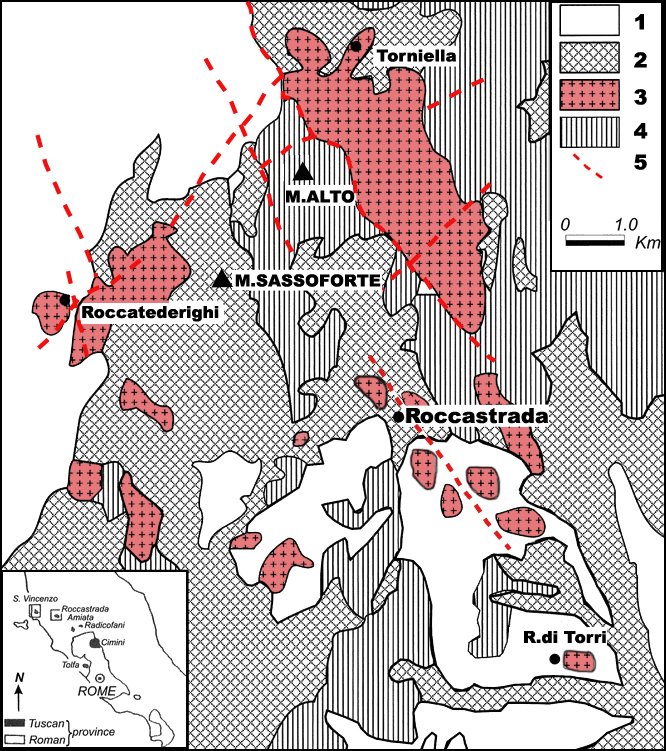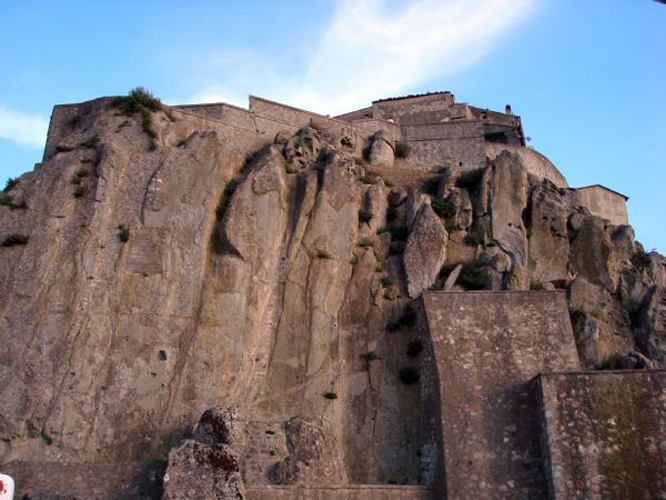Roccastrada cordierite-bearing rhyolites
The Roccastrada volcanic complex (Fig.1) is located in South Tuscany at about 40 Km NW of the Mount Amiata Quaternary volcano, and it is distribuited over an area of about 100 Km2. The complex consists exclusively of cordierite-bearing rhyolitic lavas, outpoured along a regional faults system about 2.5 Ma ago. On the basis of geochemical data, the Roccastrada volcanites can be divided into two groups, the High-Rubidium rhyolites (H-Rb) and the Low-Rubidium rhyolites (L-Rb), cropping out at East and at West of the M.Alto ridge, respectively. These geochemical characteristics associated to 87Sr/86Sr value variations are probably related to a different degree of partial melting of the crustal source.
Fig.1: Schematic geological map of Roccastrada area.; 1: Lugurids (ophiolites); 2: Neogene deposits; 3: Roccastrada Pliocenic volcanites; 4: Palaeozoic-Triassic Quartzites and phyllites; 5:Faults. Modified fom Poli.G et al. (2003).
According to Mazzuoli (1967) there are two volcanic vents: one, located north of M. Sassoforte along a SW-NE trending fault, emitted the flows outcropping West of M. Alto; the second vent, located at the intersection of two regional faults south of Torniella village, emitted the volcanites outcropping East and South-East of M.Alto and at Roccastrada village.
There is no evidence of explosive activity in the Roccastrada area, except for local explosions occurring during dome emplacement, which gave rise to very limited pyroclastic deposits (Rocca di Torri and Torniella units).
The main volcanic structures recognizable west of M. Alto are (Fig.1):
1) the large lava dome of Mt. Sassoforte (about 2.7 km2 ) dislocated by two fault systems;
2) the large lava flow extending for about 11 km2 south of Mt. Sassoforte with a thickness ranging between 2 and 10 meters, rarely exceeding 10 meters;
3) the small dome of Roccatederighi (0.2 km2) with subvertical flow-bands in the outer portions and a massive lava core characterized by large sanidine phenocrysts and altered cordierite crystals of 0.3/0.5 cm.
On the Eastern flank of M. Alto the volcanites are characterized by a series of lava domes and lava flows outpoured from fractures with a NW-SE direction (Fig.1). In the northern sector (Torniella Area) small, occasionally isolated lava domes with scarce and limited, usually autobrecciated, lava flows are found. In the Seguentina Valley lavas reach a maximum thickness of about 100 meters. In this area the lavas, generally glassy, are intensely autobrecciated and affected by oxidation processes. From Roccastrada village to Rocca di Torri, small lava domes are roughly aligned along a NW-SE direction. This trend corrisponds to the main Apenninic fault system, not easily recognizable in the field in this area due to the presence of a clay-rich Neogenic deposits.
Analyses of aerial photos and field data revealed that the majority of the Roccastrada volcanites were erupted along fractures with NW-SE Apenninic trend. The largest volumes of lavas, however, were emitted in correspondence of Mt. Sassoforte and the Seguentina Valley, where the Apenninic and Antiapenninic regional trends (NW-SE and NE-SW) match.
Petrography
The Roccastrada rhyolites are characterized by porphyritic texture, with about 35-40% of phenocrysts consisting of sanidine, quartz, plagioclase, biotite and cordierite. Apatite, zircon, ilmenite and sillimanite (as an inclusion in cordierite) are present as accessory phases. Some euhedral crystals of garnet are observed in the groundmass together with numerous metasedimentary xenoliths.Phenocrysts are set in a groundmass showing perlitic-fluidal, or microgranophyric textures. Lavas from different outcrops do not show significant textural and modal differences; only the phenocrysts from the Roccatederighi lava dome have larger sizes than those in the other rocks. Roccastrada lavas sometimes contain metasedimentary enclaves, of microscopic size, mainly consisting of xenomorphic quartz and biotite.
Quartz: phenocrysts are generally characterized by embayed rims, whereas the microphenocrysts usually have an euhedral habits.
Sanidine: occurs in large euhedral crystals, often fractured; some crystals show resorption rims. Somewhere it shows poikilitic texture with plagioclase microcrystals, biotite and rarely cordierite inclusions. In the lava from the inner portion of the Roccatederighi dome, the phenocrysts of sanidine can reach 8 cm in length.
Plagioclase: is commonly present either in glomerophyric aggregates or individual crystals. Sometimes rims are mantled by sanidine. Both individual and cumulus phenocrysts show cores partially resorbed.
Biotite: occurs both as euhedral crystals and anhedral oxidized crystals, and often includes ilmenite, zircon and apatite.
Cordierite: generally represents 1-2 vol.% of the rock and occurs as euhedral twinned crystals. In devitrified lavas, cordierite is always completely altered, especially in the inner portion of the Roccatederighi dome, where it is completely pinitized and reaches the 8-9 vol.% of modal content.
Petrogenesis
Roccastrada rocks exhibit some characteristics typical of crustal derived melts:i) the high values of normative corundum (more than 2.5%), ii) the relatively low Na20 contents, iii) the high Si02 contents with restricted variations, iv) the presence of refractory cordierite +/- garnet, and v) metasedimentary enclaves.
Roccastrada rocks exhibit some geochemical differences between rocks cropping out east (High Rb content) and west (Low Rb content) of M. Alto cannot be due to mineralogical differences, because they have approximately the same mineralogy. Rocks cropping out respectively east (High Rb) and west (Low Rb) of M. Alto represent two batches of magma derived from the same source, a rock similar to Paleozoic garnet-bearing micaschists, through different degrees of partial melting and with differing residual mineralogies. The slight isotopic difference observed between the High Rb and Low Rb magma batches could reflect isotopic inhomogeneity of the source.

Panoramic view of the Roccastrada village on the top the the Roccastrada Rhyolitic dome.

Roccastrada Rhyolitic dome.
1.jpg)
Panoramic view of the Roccatederighi village on the top the the Roccatederighi Rhyolitic dome.
.jpg)
Roccatederighi Rhyolitic dome.
.jpg)
Roccatederighi Rhyolitic lava.
.jpg)
Cordierite crystal in the Roccatederighi Rhyolitic lava. From Dr. Didier Descouens (Institut Picot de Lapeyrouse - Muséum de Toulouse - France).
(1).jpg)
Panoramic view of rhyolite from Roccastrada thin section. Image by Andy Tindle (Virtual Microscope). PPL image, field of view = 2.5cm.
(2).jpg)
Panoramic view of rhyolite from Roccastrada thin section. Image by Andy Tindle (Virtual Microscope). XPL image, field of view = 2.5cm.
Bibliography
• Marianelli, P., & Carletti, P. (1999): Genesis of Roccastrada volcanic rocks (central Italy): inferences from melt inclusions analyses. Period. Mineral,68(1), 69-80.
• Poli, G., & Perugini, D. (2003). Roccastrada volcanites. Per. Miner, 72, 169-181.



.jpg)
.jpg)
.jpg)
.jpg)
.jpg)
.jpg)
.jpg)
.jpg)
.jpg)
.jpg)
.jpg)
.jpg)
.jpg)
.jpg)
.jpg)
.jpg)
.jpg)
.jpg)
.jpg)
.jpg)
.jpg)
.jpg)
.jpg)
.jpg)
.jpg)
.jpg)
.jpg)
.jpg)
.jpg)
.jpg)
.jpg)
.jpg)
.jpg)
.jpg)
.jpg)
.jpg)
.jpg)